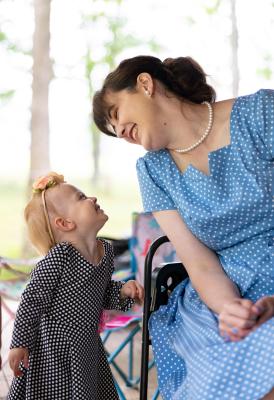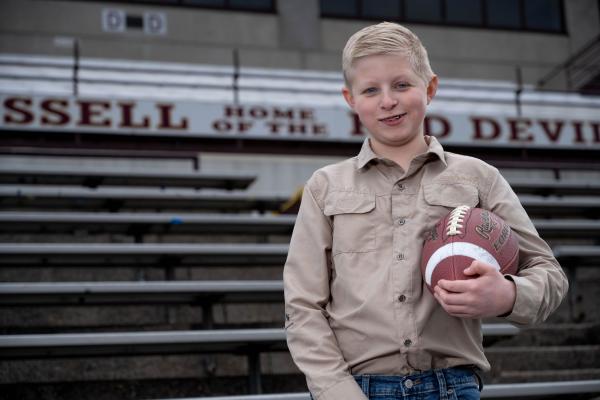





'No choice in my mind.'
Upper respiratory infections aren’t uncommon during winters in Waco, Ky. But Caroline Cain had a lot of them.
Caroline’s distress was enough to warrant chest X-rays to rule out pneumonia. While her imaging showed no signs of a bacterial infection, there was something else. A small mass in Caroline’s mediastinum — the area between the lungs — was noticeably larger compared with X-rays from previous years. Her family pediatrician referred them to a pulmonologist – a doctor who specializes in respiratory issues – who delivered even more concerning news.
“They said, ‘This doesn’t look like a pulmonary etiology,’” said Elizabeth Cain, Caroline’s mother.
Instead, they told Elizabeth, the family needed to see a cancer specialist.
“My world felt like it had shattered at that point.”
Discovering a tumor
A tumor had been growing inside of Caroline for three years. That much was known before the family met Dr. Amanda Harrington, who works in the DanceBlue Pediatric Hematology & Oncology Clinic at Kentucky Children's Hospital. Dr. Harrington, a children’s cancer specialist, ordered the labs and additional imaging that helped confirm the nature of the tumor.
A biopsy eventually led to diagnosis of a ganglioneuroma, a rare tumor of the fibers in the autonomic nervous system. Ganglioneuromas, sometimes called ganglioma, tend to occur most in young women and girls, but, fortunately, are rarely cancerous.
“Caroline’s presentation was typical in that it was found incidentally and had been present for years,” Dr. Harrington said. “These benign tumors don’t usually cause symptoms.”
An MRI showed the tumor originated from the lower area of her spine and was getting closer to Caroline’s renal arteries, which provide oxygen to the kidneys.
Elizabeth, a registered nurse, and Caroline’s father, Chad , did their due diligence and decided Dr. Eric Rellinger, the pediatric surgeon with whom the family had been in conversations at Kentucky Children's Hospital, would perform the necessary surgery.
“I mean, there was just really no choice in my mind,” Elizabeth said. “I just felt comfortable at UK, and that’s where I wanted to be with my child.”
Caroline, who was six years old at the time, latched on quickly to “Dr. Eric,” and continues to ask about him now that she has recovered. She was as invested in her care at UK as her parents.
“Caroline is an energetic, sweet and thoughtful girl,” Dr. Rellinger said. “She asked a lot of questions that reflect her natural curiosity towards medicine. … Caroline has been steadfast throughout her course of treatment, and her strength and trust in our team was inspiring.”
An advanced surgical option
After many conversations, Caroline’s family and her care team at UK landed on thoracoscopic surgery as the best way to remove her tumor and provide the best outcome.
Thoracoscopic surgery, or video-assisted thoracic surgery, is a minimally invasive alternative to open-chest procedures. A surgeon makes small incisions in a patient’s chest wall and uses a thin tube with an attached camera — a thoracoscope — to visualize the chest cavity through one of the incisions. The surgeon then operates by guiding instruments through the other small incisions.
Thoracoscopy has been performed at Kentucky Children's Hospital for more than a decade, but its use in the removal of ganglioneuroma and similar tumors is just gaining popularity. Kentucky Children’s Hospital sees about two or three patients with ganglioneuroma each year, and Dr. Rellinger previously had great success using thoracoscopy to remove them. However, the location of Caroline’s tumor — extending above and below the diaphragm (the muscle that separates the chest and the abdomen) — presented a bigger challenge.
Typically, he said, tumors like Caroline’s require a more invasive approach. Dr. Rellinger prepared Caroline and her family for a worst-case scenario. If the original plan didn’t pan out, she would end up with a large incision from her armpit to her abdomen, leading to a longer hospital stay and a large scar she’d carry for life. A more invasive surgery would also heighten Caroline’s risk for future issues related to the chest wall, like scoliosis.
“Knowing the risks and benefits, I felt strongly that trying a minimally invasive approach was what I would want for one of my own children,” Dr. Rellinger said.
'It's going to be OK, Mommy'
Caroline was a rock leading up to her surgery.
“She didn’t really have a care in the world,” Elizabeth said. “She kept telling me, ‘It’s going to be OK, Mommy.’ We had a prayer bear that some people from our church bought her, and prayer cloths and a rosary. She never really showed any fear. It was pretty amazing.”
Elizabeth’s emotions, on the other hand, ran high, especially on the day of surgery. The reassurance she got from Caroline’s care team helped steady her.
“The head of anesthesiology (Dr. Sarah Hall) came in the morning of her surgery and sat down with me as a mother,” Elizabeth said. “You don’t see that out of every healthcare provider. She had tears in her eyes, I had tears in my eyes.
“She sat there with me, as a mom, just for a moment in time. I still have a picture of her and Caroline sitting on the bed, so happy together.”
Dr. Hall admired the family’s bravery throughout a terrifying time. She’s proud to have played a crucial role in their care, medically and emotionally.
"As a parent, I take the responsibility of anesthetizing someone's child very seriously and treat them how I would want my own child treated,” Dr. Hall said. “The last thing I tell babies and children before they go to sleep is ‘I love you,’ and I absolutely mean it.
"The moment I stop falling in love with every child I care for, I need to find a new career. But I don't see that ever happening.”
Personalized care at Kentucky Children's Hospital
Plan A worked: Dr. Rellinger was able to resect Caroline’s tumor — about four inches long, or the width of a typical smartphone — through the less-invasive procedure , allowing for a speedier recovery and decreased risk of infection.
During her short hospital stay, Caroline found joy in the people who cared for her. In addition to “Dr. Eric” and others involved with her surgery, she loved chatting up the nurses who visited her. One, a travel nurse named Maddie, had a name badge colored like a cow that she still talks about.
“Caroline loves Twilight, and her nurses actually decorated her door with Twilight stuff,” Elizabeth said. “And they gave her a card when she was being discharged. They took time to do stuff like that.”
While she had about as smooth and enjoyable a hospital experience as a kid can have, Caroline was excited to return home to her dogs, cats and cattle. She has an affinity for gymnastics and cheerleading and now gets to take to the mat with a couple of tiny scars and a carefree spirit.
Her follow-up imaging has shown no signs of the tumor coming back or complications from her surgery — a procedure that will continue to offer hope for kids just like her.
“My goal each day is to try to make the greatest impact that I can to advance the care of children here in the Commonwealth and beyond,” Dr. Rellinger said.
“Some days that involves operating,” he said. “Some days that entails performing research. And other days, it is focused on inspiring groups … to build clinical programs to advance what our healthcare system has to offer for the children and families we are privileged to care for.”

























